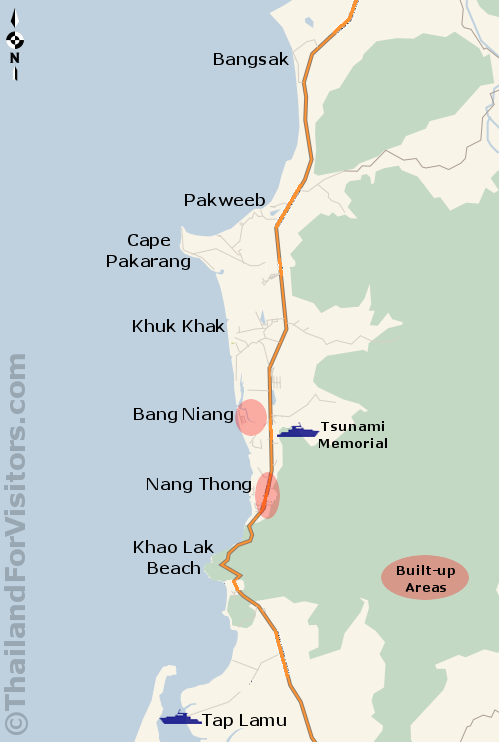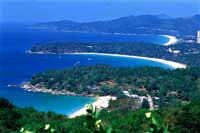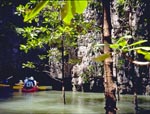Bangkok Rooftop Bars and Restaurants
Bangkok is home to some excellent rooftop bars and restaurants with great views of the city. Although drinking or dining at some of these venues can be expensive by normal Thai standards, the experience is unique enough to make it a justifiable extravagance for your trip to Bangkok. Enjoy a Siam Sunrays cocktail as the sun sets on the Thai capital and enjoy great rooftop views of Bangkok. The majority of these venues have a smart-casual dress code so forget about the sandals and shorts.Moon Bar and Vertigo @ Banyan Tree
 Even if you’re not scared of heights, one look at the seemingly flimsy perimeter fencing on the rooftop might give you cause to worry! That aside, the views over Lumpini Park and downtown Bangkok are superb and the Vertigo Grill has earned a good reputation over the years for the quality of its food. Not a cheap place to drink or dine, but certainly a memorable one.
Even if you’re not scared of heights, one look at the seemingly flimsy perimeter fencing on the rooftop might give you cause to worry! That aside, the views over Lumpini Park and downtown Bangkok are superb and the Vertigo Grill has earned a good reputation over the years for the quality of its food. Not a cheap place to drink or dine, but certainly a memorable one. Location: Banyan Tree Hotel, South Sathorn Road, Bangkok
Nearest Skytrain: Lumpini
Stay at the Banyan Tree, Bangkok »
Baiyoke Sky Hotel
The tallest hotel in Thailand houses the country’s highest entertainment venue with the revolving rooftop bar on the 83rd floor. The Baiyoke Sky Hotel is 309 metres high and if the rooftop bar isn’t to your taste, try the Bangkok Sky Restaurant on the 76th floor or the Crystal Grill on the 82nd floor. Even if you aren’t going there to eat or drink, you can still buy a ticket to visit the observation deck on the 77th floor for fantastic 360° panoramic views of Bangkok.Location: Baiyoke Sky Hotel, 222 Ratchaprarop Road, Bangkok
Nearest Skytrain: Phya Thai
Stay at the Baiyoke Sky Hotel, Bangkok »
The Dome and Lebua at State Tower
 Bangkok’s second highest building hosts a number of bars and restaurants with different names and themes. When the Sirocco restaurant opened for business it had the distinction of being the world’s highest open-air restaurant. A small staircase leads from the restaurant up to the circular Sky Bar (pictured right). The setting is spectacular with views over Bangkok and the Chao Phraya River. This is a popular venue for well-to-do Thais as well as overseas visitors and is one place where dress codes are more likely to be adhered to. Expect to be scrutinized by the staff before you’re even allowed in the lift that takes you to the top floor. Definitely worth the effort for a cocktail at sunset. If it does rain, diners are moved inside to the level just below the rooftop. The top floor also has an oyster bar and the Distil Bar for whisky connoisseurs or you can reserve a table at the Breeze restaurant with its stunning glass walkway.
Bangkok’s second highest building hosts a number of bars and restaurants with different names and themes. When the Sirocco restaurant opened for business it had the distinction of being the world’s highest open-air restaurant. A small staircase leads from the restaurant up to the circular Sky Bar (pictured right). The setting is spectacular with views over Bangkok and the Chao Phraya River. This is a popular venue for well-to-do Thais as well as overseas visitors and is one place where dress codes are more likely to be adhered to. Expect to be scrutinized by the staff before you’re even allowed in the lift that takes you to the top floor. Definitely worth the effort for a cocktail at sunset. If it does rain, diners are moved inside to the level just below the rooftop. The top floor also has an oyster bar and the Distil Bar for whisky connoisseurs or you can reserve a table at the Breeze restaurant with its stunning glass walkway. Location: The Dome, Lebua at State Tower, 1055 Silom, Bangkok
Nearest Skytrain: Saphan Taksin
Stay at Lebua, State Tower »
The Nest @ Le Fenix Hotel
 The Nest rooftop bar might not be as high up as some of its competitors, but what it may lack in height it makes up for with personality. Featuring padded hammocks and ultra-cosy ‘nest’ shaped seats, the bar also has the benefit of a 160ft retractable roof for when it rains. If the skies are clear you will enjoy 360° city views. The venue sometimes hosts club music nights popular with a younger crowd and the Nest is a popular starting point before heading off to the nearby Q Bar or the Bed and Supper Club.
The Nest rooftop bar might not be as high up as some of its competitors, but what it may lack in height it makes up for with personality. Featuring padded hammocks and ultra-cosy ‘nest’ shaped seats, the bar also has the benefit of a 160ft retractable roof for when it rains. If the skies are clear you will enjoy 360° city views. The venue sometimes hosts club music nights popular with a younger crowd and the Nest is a popular starting point before heading off to the nearby Q Bar or the Bed and Supper Club. Location: Le Fenix Hotel, Sukhumvit Soi 11
Nearest Skytrain: Nana
Stay at Le Fenix Hotel, Sukhumvit, Bangkok »
The Long Table
This popular restaurant takes its name from the centre-piece teak dining table that is supposedly the longest dining table in the world which is 25 metres long and seats up to 70 people. The restaurant is indoors on the 25th floor, but floor to ceiling windows give impressive views. The windows open on to a wide outdoor terrace with unobstructed 180° views of the Bangkok skyline. Popular on Friday and Saturday nights with Bangkokians and advance booking may be required on these nights.Location: 25th Floor, 48 Column Residence Building, Sukhumvit Soi 16 (Sammit)
Nearest Skytrain: Asoke
Millenium Hilton
 The enclosed 360° rooftop lounge on the 32nd floor of the Millenium Hotel provides some of the best views over Bangkok and the Chao Phraya River. The atmosphere is relaxed and romantic. A great venue for cocktails with the accompaniment of some mellow jazz music in the background.
The enclosed 360° rooftop lounge on the 32nd floor of the Millenium Hotel provides some of the best views over Bangkok and the Chao Phraya River. The atmosphere is relaxed and romantic. A great venue for cocktails with the accompaniment of some mellow jazz music in the background.Location: 123 Charoen Nakorn Road (Thon Buri side of the Chao Phraya River)
Nearest Skytrain: Krung Thonburi
Stay at the Millenium Hilton Hotel, Bangkok »
Gazebo
Gazebo bar and restaurant has two locations in Bangkok: Khao San Road and Sukhumvit. Both venues have a Moroccan theme and as well as food and drink, live bands entertain the crowds with a mix of Thai and Western music. The rooftop terrace is a feature at both locations. Look out for promotional nights and discounts, but generally speaking expect to pay approximately 200 Baht for a cocktail, 150 Baht for a small beer and 70 Baht for a soft drink or coffee. Entrance after midnight is usually charged at 300 Baht.Khao San Road Location: 44 Rooftop, Chakkrabong Road (just round the corner form Gulliver’s Tavern where Khao San Road meets Chakkrapong Road).
Nearest Skytrain: none within comfortable walking distance
Sukhumvit Location: Rooftop, Building 1, Sukhumvit Soi 1
Nearest Skytrain: Ploenchit
Rib Room & Bar @ Landmark Hotel
 The rooftop steak-house and bar on the 31st floor of the Landmark Hotel has seating for just 64 diners. Expect a pleasant ambiance with subtle background music and good views over the city.
The rooftop steak-house and bar on the 31st floor of the Landmark Hotel has seating for just 64 diners. Expect a pleasant ambiance with subtle background music and good views over the city.Location: Landmark Hotel, 138 Sukhumvit Road
Nearest Skytrain: Nana
Stay at the Landmark Hotel, Bangkok »
photos from Agoda, Bangkok hotels
Related Articles:





 It is true to say that Thailand is better known for its food rather than its beer, but there are a number of locally produced beers that visitors might enjoy during their trip to Thailand. One of these is Singha beer which is often marketed as being the national beer of Thailand with the tagline, ‘beer Singha, beer Thai’.
It is true to say that Thailand is better known for its food rather than its beer, but there are a number of locally produced beers that visitors might enjoy during their trip to Thailand. One of these is Singha beer which is often marketed as being the national beer of Thailand with the tagline, ‘beer Singha, beer Thai’. Wherever you go in Thailand you will see Buddha images and it doesn’t matter how small, old or what state of disrepair it may be in, the image is still sacred. Standing on an old Buddha statue to have your photograph taken is one of the most disrespectful things that you can do in Thailand because you are placing the lowest (the feet) upon the highest (Buddha). That’s not to say that you can’t photograph Buddha images because you can, but you have to display some respect and courtesy. As photogenic as some of the giant Buddha images are, don’t let your children or anybody else climb onto them for that perfect photo opportunity and also you shouldn’t really use Buddha images as part of a portrait photo. It’s perfectly acceptable to have your photo taken in front of a wat (temple), but disrespectful to pose against a Buddha image.
Wherever you go in Thailand you will see Buddha images and it doesn’t matter how small, old or what state of disrepair it may be in, the image is still sacred. Standing on an old Buddha statue to have your photograph taken is one of the most disrespectful things that you can do in Thailand because you are placing the lowest (the feet) upon the highest (Buddha). That’s not to say that you can’t photograph Buddha images because you can, but you have to display some respect and courtesy. As photogenic as some of the giant Buddha images are, don’t let your children or anybody else climb onto them for that perfect photo opportunity and also you shouldn’t really use Buddha images as part of a portrait photo. It’s perfectly acceptable to have your photo taken in front of a wat (temple), but disrespectful to pose against a Buddha image.

































.jpg)